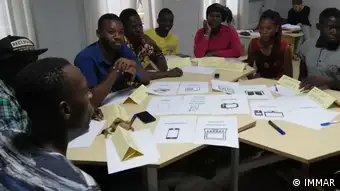MIL INDEX
MIL INDEX Methodology
Introducing the mixed methods design developed to assess the Media and Information Literacy of 15-to-35-year-olds in six African countries.
The MIL INDEX study in Africa is based on a mixed methods design. Three techniques were employed and triangulated to arrive at the results presented in the country reports: focus groups, key informant interviews and representative surveys. All methods were guided by DW Akademie’s MIL model which subdivides Media and Information Literacy (MIL) into five dimensions: access, analysis, reflection, creation and action (see concept article for details). This article goes into more detail on the individual methods. Please note that we have also attached Excel files with key findings of the quantitative data for Burkina Faso, Ghana and Kenya below this methods introduction.
Focus Groups
In each of the six African countries involved, eight focus groups were conducted with adolescents and young adults aged 15 to 35 years. Four focus groups took place in rural or peri-urban settings, while the other four were conducted in urban centers. The groups were also differentiated by age, with the younger teenagers taking part in separate discussions from their older counterparts. The focus group guides were refined with DW Akademie’s country teams and market research partners. There was a strong focus on interaction and tasks to supplement the verbal discussions taking place. The participants also filled in an accompanying questionnaire. The focus group guide was structured as follows:
- Media ranking: the relative importance of different types of media (devices) for participants’ lives
- Media brands: advantages and problems of different sources of local information
- Topics of interest: what kinds of topics and thematic areas participants are interested in and why
- Trustworthiness: what media they trust and do not trust and why
- Hopes and worries: what the young generation hopes for or fears
- Hopes and worries and the media: how media and digital communication can help realize their hopes and overcome their fears
- Media problems: negative experiences and coping strategies with a special focus on cyberbullying and disinformation
In total, 421 youths took part in 48 focus groups.
Key Informant Interviews

Awo Aidam Amenyah, CEO of Child Online Africa, one of the experts interviewed for the MIL INDEX study
Eight experts were interviewed in each of the six countries, with the exception of Burkina Faso (6) and Ghana (7). Two experts per country were chosen from four fields of expertise: youth, media, education and MIL. The interview guides were based on DW Akademie’s five MIL dimensions (see above):
- MIL definition: experts define MIL in their own words
- Media access and use: country-specific insights on issues of access and use, focusing on the young generation
- Media knowledge: knowledge resources and analytical skills of the young generation
- Media reflection: spaces for reflecting on one’s own media behavior
- Creative skills: forms of engagement in and with (digital) media
- Forms of malcommunication: country-specific information on cyberbullying, hate speech, disinformation and other problematic types of communication
- MIL and media at school: status of MIL and media in the education system
- MIL at the policy level: stance of governments on MIL
- MIL landscape: important MIL actors and initiatives at the country level
In total, 45 experts were interviewed.
Representative Surveys
Quantitative surveys based on multi-stage random samples were conducted in three countries: Burkina Faso, Ghana and Kenya. The studies are representative for 15-to-25-year-olds in the three countries and were backed up by plans to ensure that urban/rural and gender quotas are fulfilled. The questionnaire was, once again, guided by DW Akademie’s MIL model:
- Access: device ownership, frequency of (digital) media use, frequency of mobile app use, Internet access, sites of (digital) media use, topics of interest
- Analysis: evaluation of media landscape, knowledge on social media, journalism, media genres and right to freedom of expression
- Reflection: evaluation of malcommunication (hate speech, disinformation, cyberbullying, news bias, censorship), MIL self-appraisal, tolerance towards malcommunication (hate speech, disinformation, cyberbullying, news bias, censorship)
- Creation: frequency of creative practices (photo, video, audio, editing), frequency of digital practices (uploads, messenger groups, social media profile updates, programming)
- Action: activism (sharing, commenting, campaigning), putting MIL skills into practice
Overall, 3.813 youths were interviewed face-to-face for the surveys.
MIL INDEX Scores
The quantitative MIL INDEX score in the Burkina Faso, Ghana and Kenya reports is derived from the quantitative survey items for each of the five dimensions. The scores are based on a 100-point system, with 20 points allocated to each dimension:
- Access: diversity of media use, diversity of media used for news and information
- Analysis: media knowledge on social media, journalism, media genres and right to freedom of expression
- Reflection: evaluation of malcommunication (hate speech, disinformation, cyberbullying, news bias, censorship)
- Creation: frequency of creative practices (photo, video, audio, editing), frequency of digital practices (uploads, messenger groups, social media profile updates, programming)
- Action: activism (sharing, commenting, campaigning), putting MIL skills into practice
The focus on key capabilities, attitudes and behavior allowed us to develop a short-hand MIL INDEX score for the representative samples of 15-to-25-year-olds in each of the three countries.
DW recommends
- Date 23.10.2020
- Author Dennis Reineck
- Feedback: Send us your feedback.
- Print Print this page
- Permalink https://p.dw.com/p/3kLGx
- Date 23.10.2020
- Author Dennis Reineck
- Send us your feedback.
- Print Print this page
- Permalink https://p.dw.com/p/3kLGx


